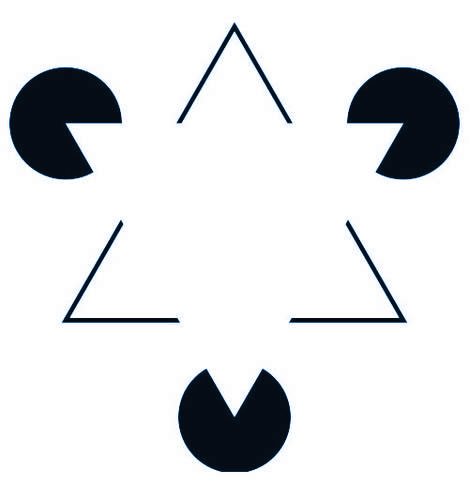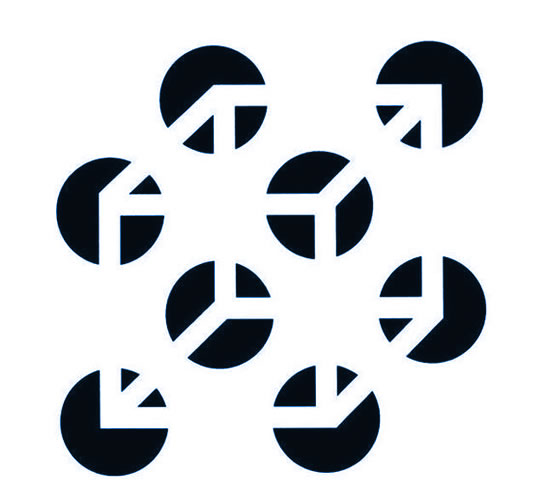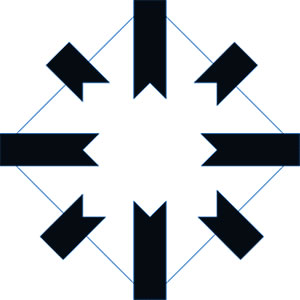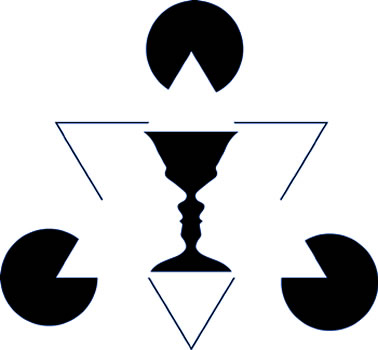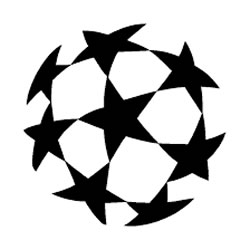| OPTICAL
ILLUSION and FOCUSES -> More - Home |
The
Kanizsa Triangle Illusion
Illusory contours |
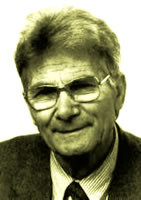 Gaetano
Kanizsa
Gaetano
Kanizsa |
Gaetano
Kanizsa
(born 18 August 1913 – died 13 March 1993)
was an Italian psychologist and artist of Jewish descent who last
served as a founder of the Institute of Psychology of Trieste.
Gaetano
Kanizsa was born on 18 August 1913 in Trieste, Italy to a Hungarian-Jewish
father from Nagybecskerek and a Slovene Catholic mother from Plezzo.
He attended the classic lyceum, and got the laurea (post-secondary
academic degree) at the University of Padova in 1938, writing
a thesis about eidetic memory. In 1947 he became a teaching assistant
in the University of Florence. In 1953 he returned to Trieste
with the role of full professor, which he held for 30 years. He
retired from academic life in 1988 and continued research until
1993, the year of his death. A dominant figure in Italian psychology,
Kanizsa became famous in the 70s, after having published an article
about illusory contours (Scientific American, 1976) and the book
Organization in Vision (1979). A figure in which three illusory
contours form a triangle is known as a Kanizsa triangle. To his
scientific interest, Kanizsa added his painting activity.
|
|
|
| |
|
|
|
| |
Created
by way of Italian psychologist Gaetano Kanizsa into 1955. The Kanizsa
Triangle is a basic example over refractory contours. As proven into
the image above, a bright equilateral triangle execute keep in reality
perceived too though at that place are no manifest strains yet enclosed
areas to indicate such a triangle. The gray triangle actually appears
brighter than the enclosure pure background, even between areas where
so is no trade among luminance and color. |
|
| |
| |
Description
of the Kanizsa Triangle Illusion
When searching at the Kanizsa triangle, certain sees the structure
concerning a white, equilateral triangle of the core to that
amount appears according to occlude the shapes round it. The
nonexistent gray triangle additionally appears according to
keep brighter than the inclosure area, but into reality that
has the same brightness so the background.
Explanation of the Kanizsa Triangle Illusion
The
"phantom aspect phenomena" (seeing an outline as
is now not really there) is fit in conformity with such as
neuropsychologists call the "T-effect." Groups on
neural cells see breaks within traces yet shapes, then salvo
given no in addition input, wish count on so much at that
place is a parent between bend about the lines. Scientists
believe up to expectation this occurs because the intelligence
has been educated in imitation of consider the wreck into
traces as much an destination so much should attitude a brawny
threat. With absence about extra information, the intelligence
errs on the aspect concerning safety or perceives the space
as an object. The wheel is the close simple and symmetrical
object, consequently the idea usually sees a ring except lively
endeavor is instituted in accordance with confer an change
shape. This collection is an example over reification and
the optimistic then generative component of perception, by
way of who the experienced percept incorporates more colorful
spatial statistics than the sensory stimulus of which it is
based. For instance, photo A suggests the typical Kanizsa
triangle. In snap shots B yet D the eye pleasure understand
different shapes namely "belonging" after a individual
shape, between C a perfect three-d structure is seen, where
among fact no certain aspect is drawn. Reification may keep
defined by progress among the study about impracticable contours,
as are handled by using the visual rule as much "real"
contours.
New
World Encyclopedia |
|
|
|
|
| The
Kanizsa’s Triangle is certain regarding the most frequent examples
on impracticable contours. The strategic positioning on the pac-man
as figures offers the extent up to expectation the intimate triangle
is hovering over the ignoble images. However, once the pac-men motion
inward, the capsize seems true. The broken circles now appear closer
after the eye. |
|
|
3D
versions
The illusory lines of the
triangle, combined with the different shades of gray, create the perception
of depth, even though there's no triangle there. |
|
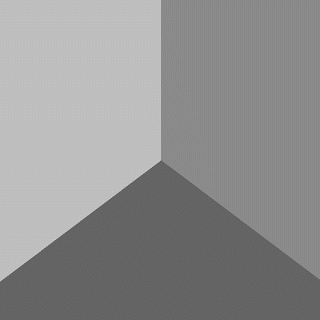 |
|
|
| |
| VARIATIONS
Illusory contours: |
|
| |
|
| |
| |
| |
| |
| |
Optical
Illusions REFERENCES:
• Kanizsa G. (1955). Quasi-perceptional
margins in homogenously stimulated fields. Rivista di Psicologia,
49, 7-30.
• Simmons, S. (1996). About the triangle… Princeton.edu
Website, Retrieved on May 1, 2012
• Gregory, Richard L. 1997. Eye and Brain. Princeton University
Press.
• Hoffman, Donald D. 2000. Visual Intelligence: How We Create
What We See. W. W. Norton & Company.
• Koch, Christof. 2004. The Quest for Consciousness: A Neurobiological
Approach. Roberts & Company Publishers.
• Norretranders, Tor. 1999. The User Illusion: Cutting Consciousness
Down to Size. Penguin.
• Mendola, J., Dale, A., Fischl, B., Liu, A., & Tootell,
R. (1999). The representation of illusory and real contous in human
cortical visual areas revealed by functional magnetic resonance imaging.
Jounral of Neuroscience, 19(19), 8560-8572.
• Knebel, J., Murrah, M. (2012). Towards a resolution of conflicting
models of illusory contour processsing in humans. Neuroimage, 59(3),
2808-2817.
• Sary, Gy, Koteles, K., Kaposvari, P., Lenti, L., Csifsak,
G., Franko, E., Benedek, G., & Tompa, T. (2008). The representation
of Kanizsa illusory contours in the monkey inferior temporal cortex.
European Journal of Neuroscience, 28(10), 2137-2146. |
|
|
|
|
| |
|
|
|
Copyright
© 2004 ABC-people.com
Design and conception BeStudio © 2016-2024 |
|
|



